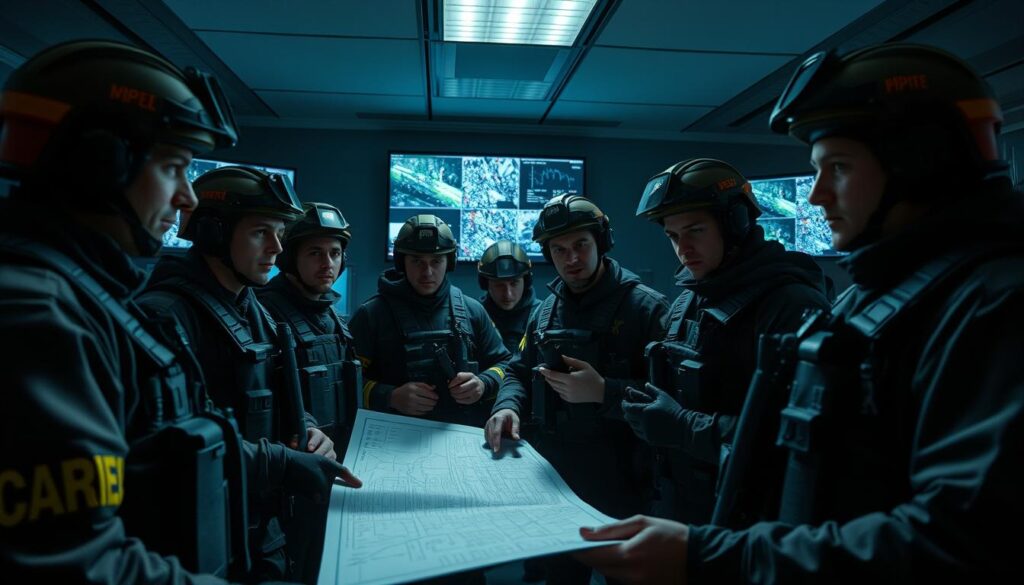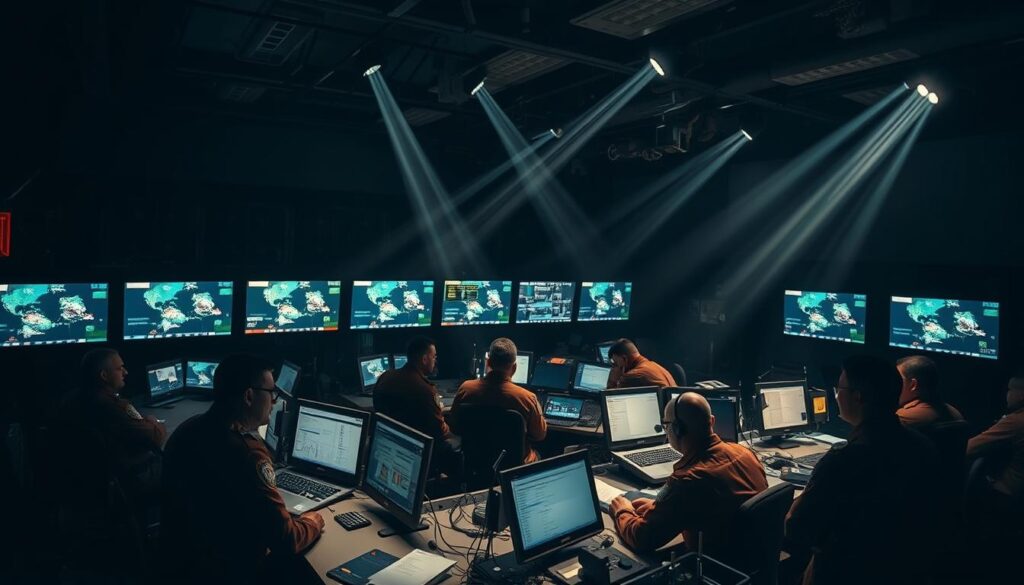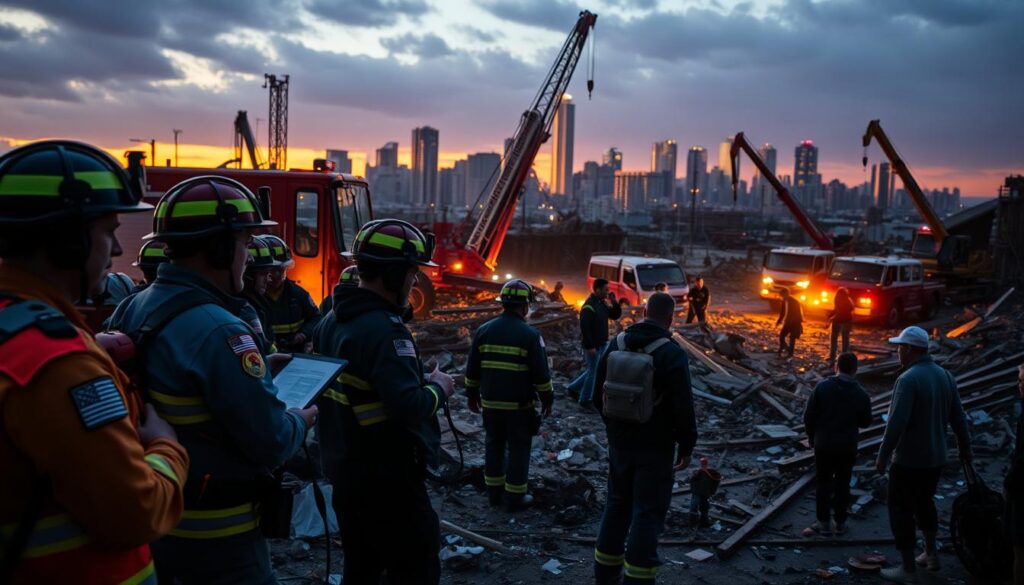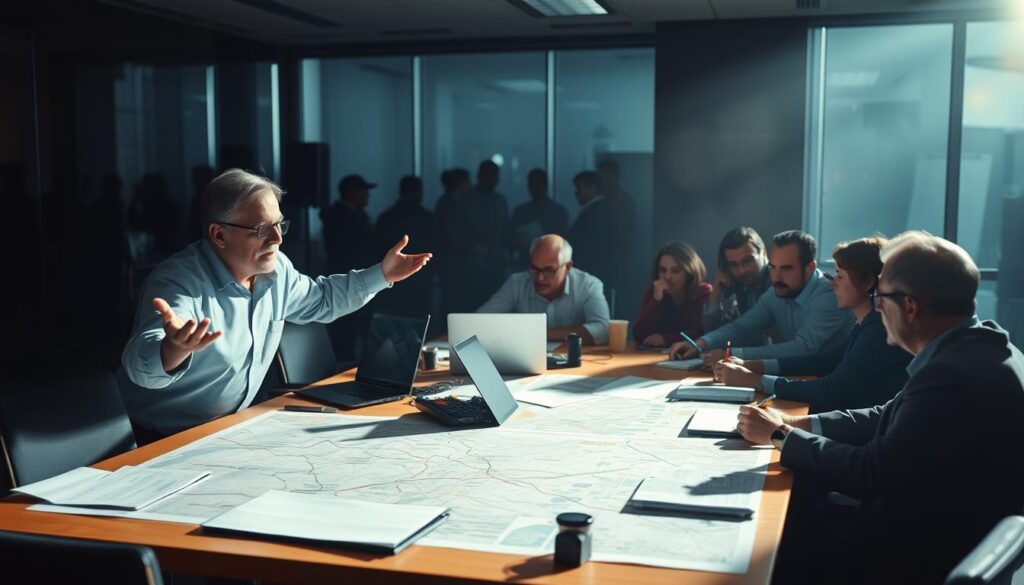Thinking about being ready for surprises makes me realize how key emergency coordination is. It’s vital for a quick and effective response.
The FEMA Guide (CPG 101, Version 2.0) shows us the importance of working together in crisis management. It’s essential for saving lives and lessening disaster damage.
Learning emergency coordination helps us all respond better to emergencies. This way, we can protect people and property from harm.
Key Takeaways
- Understanding the importance of emergency coordination in crisis management.
- The role of the FEMA Guide (CPG 101) in improving readiness.
- Key principles for effective emergency coordination.
- Strategies for better crisis management through teamwork.
- Best practices for mastering emergency coordination.
Understanding the Basics of Emergency Coordination
Knowing the basics of emergency coordination is key for a good disaster response and recovery. It brings together different groups, resources, and efforts to lessen emergency impacts.
What is Emergency Coordination?
Emergency coordination is about organizing and managing emergency responses. It uses the Incident Command System (ICS), a framework for better coordination among agencies and stakeholders. CPG101 says it’s important for a unified emergency response.
Importance of Effective Coordination
Effective emergency coordination is very important. It makes responses quick and organized, avoiding confusion and extra work. It also helps use resources well and improves communication among groups, leading to a better response.
Key Principles of Coordination
The main principles of emergency coordination are:
- Clear communication channels
- A well-defined Incident Command System
- Effective resource allocation
- Collaboration among stakeholders
These principles are key to a good emergency response plan. A well-coordinated response saves lives and lessens the economic and social effects of emergencies.
| Principle | Description | Benefit |
|---|---|---|
| Clear Communication | Establishing clear channels of communication among stakeholders | Reduces confusion and ensures a unified response |
| Incident Command System | A standardized framework for managing emergency responses | Enhances coordination and efficiency |
| Effective Resource Allocation | Allocating resources based on need and priority | Maximizes the impact of response efforts |
Preparing for an Emergency
Emergency preparedness is more than just having a plan. It’s about being proactive and identifying risks. It also means having a team ready to respond. A good emergency plan covers all types of emergencies, has a solid response strategy, and has the right team to carry it out.
Identifying Potencial Emergencies
The first step is to know what emergencies could happen. This means doing a thorough risk assessment. You need to understand the chances and impact of different emergencies, like natural disasters or human-made incidents.
Key factors to consider during a risk assessment include:
- Geographical location and its susceptibility to certain types of natural disasters
- The presence of hazardous materials or industries that could pose a risk
- The age and condition of infrastructure, such as buildings and bridges
Developing a Response Plan
After identifying emergencies, the next step is to create a response plan. This plan should cover what to do in an emergency, like evacuation routes and emergency contacts. It should also outline the roles and responsibilities of the emergency team.
A good response plan is flexible and adaptable for any emergency. It should be reviewed and updated often.
| Component | Description | Responsibility |
|---|---|---|
| Risk Assessment | Identifying emergencies and their impact | Emergency Management Team |
| Response Plan | Outlining emergency response procedures | Emergency Response Team |
| Training and Drills | Ensuring readiness through training and drills | Training Officer |
Assembling a Coordination Team
Having a coordination team is key for effective emergency response. This team should have people with different skills and expertise. This includes team leaders, support staff, and communication officers.
The team’s role is not just to respond but to make sure the response is coordinated and effective.

By identifying risks, creating a solid response plan, and having a well-coordinated team, organizations can better manage emergencies.
Roles and Responsibilities in Emergency Coordination
Emergency coordination works best when everyone knows their role. In emergency plans, knowing who does what is key to a good response.
Team Leader Duties
The team leader is very important in emergency situations. They oversee the response, make big decisions, and make sure everyone knows their job. CPG101 says clear leadership is vital for a good emergency response.
Key Responsibilities of a Team Leader:
- Coordinating response efforts
- Making strategic decisions
- Ensuring role clarity among team members
Support Staff and Their Functions
Support staff help the team leader and carry out the plan. Their jobs change based on the emergency and the team’s structure.
| Support Staff Role | Function |
|---|---|
| Communication Officer | Manages communication between teams and stakeholders |
| Logistics Coordinator | Oversees the procurement and distribution of resources |
| Safety Officer | Ensures the safety of response team members |
Community Involvement
Getting the community involved is very important. It helps with the response and recovery. Experts say, “Community resilience is key to recovering from disasters.”
“Community resilience is key to recovering from disasters.” – Emergency Management Expert
Good community involvement includes educating the public, managing volunteers, and working with local groups. By involving the community, teams can get more help and support.
Communication Strategies for Coordination
Good communication is key to successful emergency coordination. It makes sure everyone knows what’s happening. In emergencies, talking clearly is vital for a united effort.
Establishing Clear Channels of Communication
Having clear communication paths is essential. This means setting up an incident command system to define roles and tasks. An emergency operations center is where all information comes together. It’s where decisions are made and important info is shared.
For example, during emergencies, the incident command system helps teams talk and make decisions fast. The FEMA training manual shows how important talking clearly is for emergency responses.
Utilizing Technology for Enhancement
Technology is a big help in emergency communication. Emergency alert systems, mobile apps, and social media spread info quickly. These tools make teams work together faster.

Importance of Regular Updates
Keeping everyone updated is vital. It lets people know what’s happening and what’s being done. This helps manage expectations and keeps everyone working together.
| Communication Strategy | Description | Benefits |
|---|---|---|
| Establishing Clear Channels | Setting up defined communication pathways | Improved information flow, reduced confusion |
| Utilizing Technology | Leveraging technology for rapid information dissemination | Enhanced response times, better coordination |
| Regular Updates | Providing timely updates to stakeholders | Informed stakeholders, managed expectations |
Training and Drills
To be ready for emergencies, it’s key to have good training and drills. Emergency preparedness means having a plan and making sure everyone knows their role. It’s not just about having a plan.
Developing Training Programs
Creating a training program for emergency response teams starts with knowing what’s needed. You must understand the emergencies that could happen and the skills needed to handle them.
The program should cover many topics, like crisis management and using emergency gear. Scenario-based training is also helpful. It lets team members practice in a safe way.
Scheduling Regular Drills
Drills are key to staying ready. They help the team know how to act in emergencies. Drills should happen often, based on the plan’s complexity and the team’s skill.
Change the drill scenarios often to keep training interesting and challenging. This keeps the team sharp and ready for any emergency.
Evaluating Drill Effectiveness
It’s important to check how well drills go. Look at how the team did, what they could do better, and what they think. This helps make the training better.
Using what you learn from drills can make your team stronger. It helps improve crisis management skills. This way, your team can respond better when emergencies happen.
Collaborating with External Organizations
Working with outside groups is key to a good emergency response plan. A strong disaster response needs help from many places. This ensures a united and strong effort.
For incident management, outside groups offer vital support. They bring special tools, know-how, and more hands. This teamwork is vital for tackling big emergency needs.

Partnering with Local Services
Local teams like fire, police, and EMS are the first to arrive. Working with them is essential for a good disaster response. This partnership means:
- Setting up clear ways to talk
- Working together on responses
- Doing joint training to be ready
Engaging Nonprofits and Others
Nonprofits and community groups help a lot in emergencies. They bring extra help and support. To work with them, you can:
- Find out who they are and what they can do
- Make MOUs to know who does what
- Work with them during drills and real emergencies
Resources from Federal and State Agencies
Federal and state agencies have lots of help for emergencies. They offer money, technical help, and people. To get this help, you need to:
- Know what’s available and how to get it
- Build relationships with agency folks
- Keep up with policy changes and new resources
By teaming up with outside groups, communities can make their emergency response plan better. This leads to a more effective and strong response to disasters.
Managing Resources and Supplies
In emergencies, managing resources well can make a big difference. It’s key to have the right supplies ready when needed. This ensures a smooth response to emergencies.
Inventory Control Strategies
Good inventory control is essential for being ready for emergencies. It means checking supplies like food, water, and medical gear often.
Keeping track of supplies helps avoid waste. For example, using the First-In-First-Out (FIFO) method helps use older items first. This way, you always have what you need.
| Inventory Item | Quantity | Expiration Date |
|---|---|---|
| Water Bottles | 1000 | 2025-02-15 |
| Non-Perishable Food | 500 units | 2024-08-20 |
| First Aid Kits | 200 | 2026-01-10 |
Logistics Planning for Emergencies
Planning logistics is key in emergencies. It’s about moving resources to where they’re needed.
Good planning means knowing what you can do and what you can’t. It also means working with local groups to get help.
Ensuring Accessibility
It’s important to make sure resources reach those who need them. This means having the right resources and a way to get them there.
Identifying and solving problems like damaged roads helps. Using different routes or ways to travel can keep resources moving.
By focusing on managing supplies, planning logistics, and making sure resources are accessible, emergency teams can do better. This leads to a more effective emergency response.
Implementing Emergency Response Plans
An emergency response plan is key to handling incidents well. CPG101 stresses the importance of being flexible and adaptable when putting these plans into action.
Activating the Plan
Starting the emergency response plan needs quick and clear steps. It means alerting the team and starting the communication plans set up earlier.
The plan should clearly show how to start, including who does what. This helps move smoothly from regular work to emergency mode.
Coordination During the Response Phase
Good coordination during the response is vital. It means keeping in touch with the team, stakeholders, and outside groups.
Using technology, like emergency management software, helps. It gives updates in real-time and makes sharing info easier.
Adapting Plans to New Information
As things change, the plan might need updates. Being flexible and quick to adjust is important for managing incidents well.
Regular checks and updates are key. They help keep the response effective and in line with new info.
| Key Elements | Description | Benefits |
|---|---|---|
| Flexibility | The ability to adjust the plan according to new information | Enhanced response effectiveness |
| Coordination | Effective communication and collaboration among team members | Improved incident management |
| Technology | Utilization of emergency management software for real-time updates | Better information sharing and situational awareness |
Monitoring and Evaluation
The success of an emergency response plan depends on regular checks. It’s key to spot what needs work and keep the plan up to date.
Assessing Response Effectiveness
Checking how well a plan works means looking at how it was used in real emergencies. We look at how fast and well the response was, how teams worked together, and the plan’s overall effect.
Key performance indicators (KPIs) like how fast the response was, how resources were used, and how well communication was are important. They help us see if the plan was a success.
Gathering Feedback from Stakeholders
It’s important to hear from everyone involved, like team members, leaders, and those affected. We get feedback through surveys, interviews, and debriefs.
This feedback helps us understand what went right and what could be better. It gives us a full picture of the plan’s strengths and weaknesses.
Making Necessary Adjustments
After looking at the feedback and assessment, we make changes to the emergency response plan and incident management. This might mean updating rules, training staff, or better using resources.
Our aim is to keep improving emergency preparedness and response. We want to make sure our community stays safe and strong during emergencies.
Addressing Psychological Needs Post-Emergency
After an emergency, it’s key to focus on the mental health of people and communities. Emergencies can really affect our minds, causing stress and anxiety. It’s important to help people recover by addressing these needs.
Recognizing Signs of Stress
Spotting stress signs is the first step to helping others. Look for anxiety, being short-tempered, and pulling away from others. A team ready to spot these signs can make a big difference.
- Increased heart rate and blood pressure
- Difficulty sleeping or concentrating
- Feelings of overwhelm or hopelessness
For more info on getting ready for emergencies and what you need, check out emergency response essentials.
Providing Support Services
Support services are key to helping people deal with the emotional effects of emergencies. This includes counseling, support groups, and programs that improve community safety and well-being.
- Setting up counseling services for those affected
- Starting community support groups
- Creating stress management programs
Community Healing Initiatives
Community healing efforts are essential for recovery and rebuilding trust. These can include awareness campaigns, community events, and working with local groups to bring people together.
By focusing on the mental health of people and communities after emergencies, we can create stronger, more united communities. Good crisis management means responding to emergencies and also helping with the long-term mental effects.
Learning from Past Emergencies
Learning from past emergencies helps us get better at managing incidents. We can see what worked and what didn’t in previous disasters. This way, we can make our disaster response plans more effective.
Analyzing Case Studies
Looking at case studies is a great way to learn. We examine the emergency response efforts, the challenges, and the outcomes. For example, studying Hurricane Katrina showed the need for a good emergency plan.
As CPG101 says, “reviewing past emergencies helps us find the best practices and areas to improve.” This knowledge helps us update our emergency plans, making them better for the future.
Identifying Success Factors
Finding out what worked in past emergencies is key. We look at the strategies, technologies, and communication methods used. For instance, social media has been a big help in sharing information quickly.
Strong collaboration and coordination among agencies are often seen as key. Experts say, “good incident management needs smooth coordination among all stakeholders.”
Implementing Lessons Learned
The last step is to use what we’ve learned. We add the insights from case studies and success factors to our future plans. We also update training to prepare responders for new challenges.
By always learning from past emergencies and updating our strategies, we can become more resilient. This improves our disaster response abilities.
“The key to successful emergency management is not just reacting to emergencies, but learning from them to prevent or mitigate future disasters.”
Continuous Improvement in Emergency Coordination
Looking at emergency coordination, it’s clear that always getting better is key. This is true for managing crises and getting ready for emergencies. We must keep up with new challenges by updating our plans and rules.
Staying Up-to-Date with Best Practices
It’s important to check and change emergency plans often. This makes sure they work well and are up to date. We learn from past emergencies and use new ways to work together.
Innovative Approaches to Emergency Coordination
Using new tech, like better communication tools and data analysis, helps a lot. These tools make emergency teams work faster and better.
Future Trends in Emergency Management
The world of emergency management is always changing. We need to keep up with new trends and best ways to do things. This helps us get ready for future challenges and improve how we handle emergencies.
FAQ
What is the importance of emergency coordination in disaster response?
Emergency coordination is key in disaster response. It helps teams communicate, share resources, and work together. This saves lives and reduces damage, as FEMA’s guide shows.
What are the key principles of emergency coordination?
Key principles include a unified command, clear communication, and teamwork. CPG101 outlines these. They ensure a strong response to emergencies.
How do I identify potentially emergency situations?
To spot emergencies, do a risk assessment. Look at natural disasters, infrastructure risks, and community needs. This helps create a solid emergency plan.
What is the role of a coordination team in emergency response?
Coordination teams are vital. They manage communication, resources, and decisions. The team leader oversees, while support staff handle logistics and communication.
How can technology enhance emergency coordination?
Technology boosts coordination with tools for real-time communication and data sharing. Emergency software and social media can improve responses.
Why are training and drills essential for emergency preparedness?
Training and drills are vital. They prepare teams to respond well. Regular drills improve skills and confidence.
How can external organizations contribute to emergency response efforts?
Nonprofits and local services offer critical support. They bring resources and expertise. Working with them enhances the response.
What strategies are effective for managing resources and supplies during emergencies?
Effective strategies include inventory control and logistics planning. They ensure resources are used efficiently.
How can emergency response plans be adapted to new information?
Plans can adapt by monitoring situations and gathering feedback. This keeps responses effective and flexible.
Why is it essential to address the psychological needs of individuals and communities post-emergency?
It’s key to support mental health post-emergency. This promotes recovery and resilience. Support services and healing initiatives help.
How can past emergencies inform future emergency coordination efforts?
Learning from past emergencies is vital. Analyzing successes and failures helps improve future responses. This reduces disaster risks.
What is the importance of continuous improvement in emergency coordination?
Continuous improvement is vital for staying ready for new threats. Updating plans and adopting new approaches ensures effective responses.



